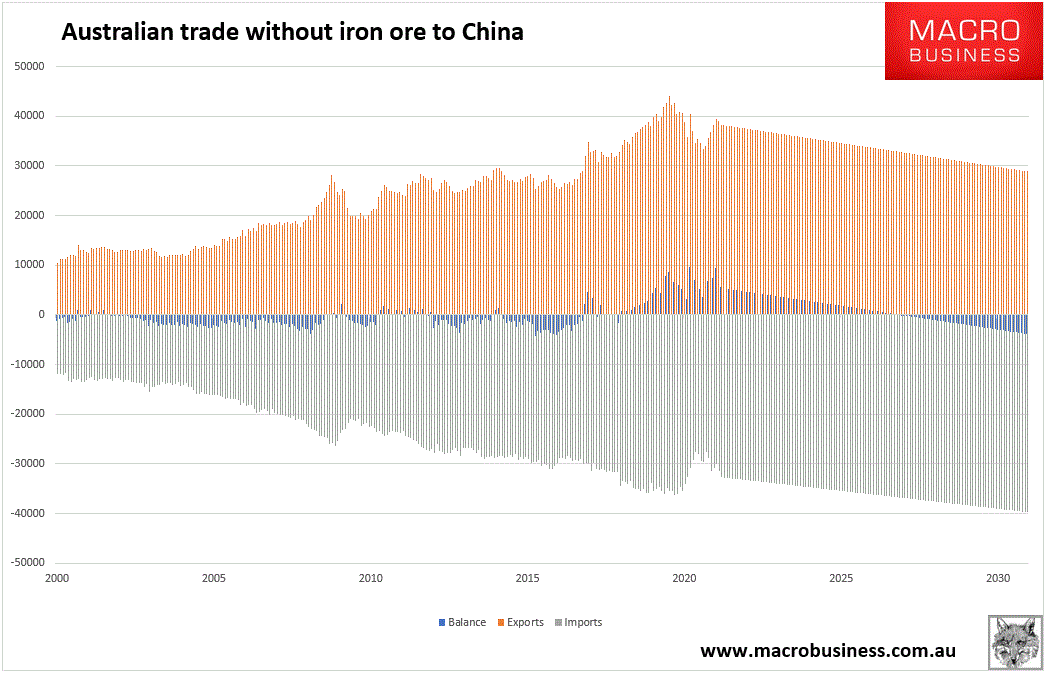Whether China cuts off Australian iron ore is not in question. Only the timing of it is. As well as what it will do to the Australian economy when it does.
The causes of the cut-off are well understood. There are three main drivers.
First, the US/China cold war is bifurcating the global economy into liberal and illiberal economic blocs. Australia has cast its lot in with the former. This makes Chinese reliance upon Australian iron ore strategically unviable.
Second, the Chinese economic development model is running out of rope. Its urbanisation is all but complete in construction volume terms. It can continue to overbuild but this is now hurting its long-term growth prospects as misallocated capital and debt kill off productivity. It must shift away from building as its primary growth driver.
Third, these two factors combine most forcibly in Chinese politics. CCP legitimacy will fail as the economy slows. It is already being replaced with deliberately stoked nationalism. This makes external conflict inevitable, most particularly in Taiwan. Yet Australia has a virtual veto over Chinese military aggression so long as China relies upon it for iron ore.
So, the CCP must break the Chinese economy’s reliance. It will do so via a combination of structural decline in steel output, a shift towards a greater share of scrap output and by seeding new iron ore developments worldwide.
The timetable for the cut-off will be this decade, probably the second half of it. China will decide precisely when by whatever combination of slowed urbanisation and magnitude of investment it determines is optimal.
What will happen to Australia then?
The first point to note is that global iron ore prices will collapse as unimaginable quantities of Aussie iron ore flood ex-China markets. China absorbs more than a billion tonnes of seaborne iron ore. Australia ships around 700mt there every year. Some large slice of this will be progressively dumped on other markets.
That means a return to $20 iron ore for a time. This will shut-in every tonne of ex-RIO and BHP iron ore, roughly 300mt of it. The remaining 600mt of Aussie iron ore still exceeds the total amount of ex-China global iron ore imports so you can see the problem.
It will not happen all at once. Rather, it will be the inverse of the 2010-2020 period during which Australian growth enjoyed a commodity volumes tailwind. GDP will be hit ceaselessly year after year as iron ore volumes fall. This will cost perhaps 200k direct and indirect jobs in WA.
But the bigger hit by far will be to national income. This year Australia will reap some $150bn in export revenue from iron ore. Nearly all of this will be wiped out by the combination of volume and price pressure.
This hit to Australia’s total exports is big but it is manageable. The following chart is a stylised version of the outcome, it would obviously be more volatile:

As you can see, it is a return to 2015 external conditions not the end of the world. That also gives us a very good guide to what will happen:
- Nominal growth will be crunched.
- Inflation and wages will be hit for years.
- The budget will be a sea of red.
- Mining stocks will fall.
- Bonds yields will plunge.
- AUD will crash.
The last point is the most important. There is no way of parsing all circumstances in this scenario but it is certain that the AUD will tumble a very long way as interest rates remain at zero (or go negative) for the entire period.
Could this result in an external crisis for the country? A balance of payments or financial crisis? Yes, but probably not.
Although I can see the AUD falling deep into the 0.40s, pushing some tradaeble inflation into Australia, the offset in weak domestic demand would prevent any kind of inflation breakout. This would enable the RBA to simply let the currency keep falling until it adjusts the external accounts to lower imports and higher non-iron ore exports.
Any potential run on the Aussie bank’s offshore debt would be mitigated by public guarantees and RBA QE.
There is a risk of sovereign downgrades but we’ve seen that markets these days are tamed by unconventional monetary policy even in that event.
No doubt you are all waiting for me to declare that Aussie house prices would tumble. And they would. They would radically devalue versus the world via the collapsing currency.
Undoubtedly, nominal prices in WA will also fall a long way given their strong correlation with iron ore. Other markets are more interest-rate sensitive. With the RBA reviving its TFF and using negative interest rates for cheap bank funding, mortgage rates could be squashed below 1%. So we might actually see another price rise in eastern capitals.
How long that would last is the more interesting question. Presuming that AUD can keep on falling without creating inflation then there is no obvious immediate limit to it.
That said, the very long term would get much more difficult for house prices with income growth yoked exclusively to non-existent productivity advances post-iron ore.
I wouldn’t recommend owning the ASX. Miners will be wiped out. Banks, too, as their margins are squashed by the RBA. That said, crashed yields would quickly restore a bid for the wider bourse.
In short, the end of iron ore to China is not the end of Australia. It would be a repeat of 2015, only permanent, but just as survivable as the cratered currency rebalanced the economy.

